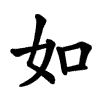Definify.com
Definition 2025
止
止
Translingual
| Stroke order | |||
|---|---|---|---|

| |||
Han character
止 (radical 77 止+0, 4 strokes, cangjie input 卜中一 (YLM), four-corner 21100)
- Kangxi radical #77, ⽌ (“stop”).
Derived characters
Descendants
References
- KangXi: page 573, character 24
- Dai Kanwa Jiten: character 16253
- Dae Jaweon: page 961, character 23
- Hanyu Da Zidian: volume 2, page 1435, character 3
- Unihan data for U+6B62
Chinese
|
simp. and trad. |
止 | |
|---|---|---|
Glyph origin
| Historical forms of the character 止
| ||||
|---|---|---|---|---|
| Oracle bone script | Bronze inscriptions | Bamboo and silk script | Large seal script | Small seal script |
 |
 |
 |
 |
 |
| Characters in the same phonetic series (止) (Zhengzhang, 2003) | |
|---|---|
| Old Chinese | |
| 祉 | *kʰlɯʔ |
| 址 | *kjɯʔ |
| 止 | *kjɯʔ |
| 趾 | *kjɯʔ |
| 芷 | *kjɯʔ |
| 沚 | *kjɯʔ |
| 阯 | *kjɯʔ |
| 齒 | *kʰjɯʔ |
| 紕 | *be, *pʰi, *kʰjɯʔ |
Pictogram (象形) – a footprint, originally meaning "toe". The derivative 趾 (OC *kjɯʔ) refers to the original meaning. Compare 手 (“hand”). Note that in oracle script, composed of 3 toes and a sole.
Compare to 夊, 夂, which have similar shape in oracle script, but pointing down (toe pointing right), and 𡕒 (as in right side of 舛, roughly ヰ, toe pointing left), hence different evolution.
Etymology 1
Pronunciation
- Mandarin
- (Standard Chinese, Beijing)+
- Pinyin:
- Zhuyin: ㄓˇ
- Wade-Giles: chih3
- Gwoyeu Romatzyh: jyy
- IPA (key): /ʈ͡ʂʐ̩²¹⁴/
- (Standard Chinese, Beijing)+
- Cantonese
- (Standard Cantonese, Guangzhou)+
- Jyutping: zi2
- Yale: jí
- Cantonese Pinyin: dzi2
- IPA (key): /t͡siː³⁵/
- (Standard Cantonese, Guangzhou)+
- Hakka
- (Sixian, incl. Miaoli and Meinong)
- Pha̍k-fa-sṳ: chí
- Hakka Romanization System: ji`
- Hagfa Pinyim: ji3
- IPA: /t͡ɕi³¹/
- (Sixian, incl. Miaoli and Meinong)
- Min Nan
- (Hokkien)
- Pe̍h-ōe-jī: chí
- Tâi-lô: tsí
- Phofsit Daibuun: cie
- IPA (Xiamen): /t͡ɕi⁵³/
- IPA (Quanzhou): /t͡ɕi⁵⁵⁴/
- IPA (Zhangzhou): /t͡ɕi⁵³/
- IPA (Taipei): /t͡ɕi⁵³/
- IPA (Kaohsiung): /t͡ɕi⁴¹/
- (Hokkien)
| Rime | |
|---|---|
| Character | 止 |
| Reading # | 1/1 |
| Initial (聲) | 章 (23) |
| Final (韻) | 之 (19) |
| Tone (調) | Rising (X) |
| Openness (開合) | Open |
| Division (等) | III |
| Fanqie | 諸市切 |
| Reconstructions | |
| Zhengzhang Shangfang |
/t͡ɕɨX/ |
| Pan Wuyun |
/t͡ɕɨX/ |
| Shao Rongfen |
/t͡ɕieX/ |
| Edwin Pulleyblank |
/cɨX/ |
| Li Rong |
/t͡ɕiəX/ |
| Wang Li |
/t͡ɕĭəX/ |
| Bernard Karlgren |
/t͡ɕiX/ |
| Expected Mandarin Reflex |
zhǐ |
| Baxter-Sagart system 1.1 (2014) | |
|---|---|
| Character | 止 |
| Reading # | 1/1 |
| Modern Beijing (Pinyin) |
zhǐ |
| Middle Chinese |
‹ tsyiX › |
| Old Chinese |
/*təʔ/ |
| English | foot; stop |
Notes for Old Chinese notations in the Baxter-Sagart system: * Parentheses "()" indicate uncertain presence; | |
| Zhengzhang system (2003) | |
|---|---|
| Character | 止 |
| Reading # | 1/1 |
| No. | 17297 |
| Phonetic component |
止 |
| Rime group |
之 |
| Rime subdivision |
0 |
| Corresponding MC rime |
止 |
| Old Chinese |
/*kjɯʔ/ |
| Notes | 趾初文 |
Definitions
止
- †foot
- to stop; to halt
- 休止 ― xiūzhǐ ― to stop
- to bring to an end; to stop; to relieve
- 止癢 / 止痒 ― zhǐyǎng ― to stop itching (irritation)
- to end; to finish
- only
Antonyms
- (stop): 始 (shǐ)
Compounds
|
|
|
Etymology 2
| For pronunciation and definitions of 止 – see 只 (“only”). (This character, 止, is a variant form of 只.) |
Japanese
Kanji
Readings
Compounds
|
|
|
Korean
Hanja
止 • (ji)
Eumhun:
- Sound (hangeul): 지 (revised: ji, McCune-Reischauer: chi, Yale: ci)
- Name (hangeul): 그칠()
- This term needs a translation to English. Please help out and add a translation, then remove the text
{{rfdef}}.
Vietnamese
Han character
止 (chỉ)
- This term needs a translation to English. Please help out and add a translation, then remove the text
{{rfdef}}.